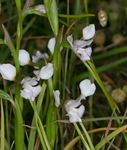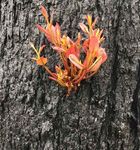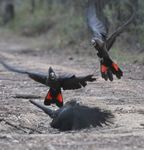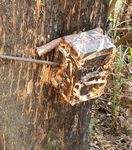About us - Arthur Rylah Institute
←
→
Page content transcription
If your browser does not render page correctly, please read the page content below
ARI Terrestrial Quarterly Update
May 2020
About us
The Arthur Rylah Institute’s terrestrial ecology teams produce high-quality science to support
evidence based decision-making by governments and communities.
Our 45 scientists have extensive expertise in fauna and flora research, ecological modelling
and data interpretation. We work collaboratively with national, state and local agencies,
universities and the community.
Bushfire Biodiversity Response: ARI at the frontline
The 2019/20 bushfires were exceptional in both size and impact. In Victoria
many areas with extremely high biodiversity value were affected. Over 170
rare or threatened species had more than 50% of their habitat impacted
by the fires. This required an immediate and informed response to Early reconnaissance of fire impacts
minimise biodiversity loss.
Scientists from the ARI were essential in generating important information
about the impact of the fires on biodiversity. Matt White (pictured
emerging from a helicopter), Peter Menkhorst, Geoff Heard, Jenny Nelson
and Nick Clemann were among the ARI staff who provided immediate Large Brown Tree Frog
(Litoria littlejohni)
expert information and resources about the threatened species likely
¯
impacted by the fires. Also, Luke Collins applied his recent research on Unburnt
Low canopy scorch
fire severity mapping to provide up-to-date fire severity maps for the fire Moderate canopy scorch
High canopy scorch
affected areas which were used to aid decision-making.
Canopy consumed
ARI staff are now contributing to a set of priority actions to help minimise
biodiversity losses, including the early reconnaissance theme being led
by Tim O’Brien.
0 5 10 20
Fire severity mapping
Kilometers Source: Esri, DigitalGlobe, GeoEye, Earthstar Geographics, CNES/Airbus DS, USDA, USGS, AeroGRID, IGN, and
the GIS User Community
ari.vic.gov.au 1ARI Terrestrial Quarterly Update
May 2020
Influencing Change
ARI turns 50!
In April 1970, ARI was formally opened by the Queen.
At the time, the State of Victoria was a global leader in the
establishment of ARI as a government science institute -
the other Australian states followed suit.
In our early years, ARI played a central role in major
biological discoveries, terrestrial examples include the
identification of the first living example of a Mountain
Pygmy Possum (by Bob Warneke) and the discovery of a Early years: lab work Early years: field work
new species of macropod, the Long-footed Potoroo (by
John Seebeck).
Today ARI fulfils a key role in generating knowledge, through world-class, applied ecological research,
which supports policy and management to ensure healthy, resilient ecosystems in south-eastern Australia.
This month the terrestrial ecology teams celebrate ARI’s 50th Birthday.
Unfortunately, plans for a large celebration were hampered by Victoria’s bushfires and the COVID-19
pandemic. However, we had a staff virtual celebration on the day and plan to have further, larger
celebrations during National Science Week (15-23 August 2020) to recognise this momentous occasion.
ARI scientists help Mallacoota residents heal after devastating bushfire
A team of both ARI aquatic and terrestrial experts (including Jemma Cripps, Nick Clemann, Michele Kohout
and Zak Atkins) joined East Gippsland Catchment Management Authority, and members of the local
community, on boat trips around Mallacoota Lakes. Discussions were held to understand the impact of the
fires on the flora and fauna of the area.
The trips were a fantastic opportunity for
locals to share their experiences of the
recent bushfire, and to discuss the impact on
ecosystems, and subsequent recovery, with
experts in that field of research.
Important equipment and data
saved from recent bushfire
Camera traps enable the collection of photos of rare and
cryptic animals that are otherwise difficult to survey.
However, cameras are often installed in remote areas
making it difficult and dangerous to retrieve during
Long-footed Potoroo bushfire and flood events.
(Potorous longipes)
Cameras collecting important data to inform the
modernisation of the Regional Forest Agreements (RFA) were
threatened by bushfires west of Harrietville in January. In a
great example of swift action, they were recovered with the
aid of both regional DELWP staff deployed to the fire, and
ARI researchers. Images on the cameras included records of
Long-footed Potoroos (‘Endangered’ under the EPBC Act 1999).
These records have since been used to inform fire response
actions for this species and will be used to update habitat
Camera trap distribution models for the RFA. 2
ari.vic.gov.auARI Terrestrial Quarterly Update
May 2020
Influencing Change
Glossy Black-Cockatoo: a species on the brink?
While specialisation can reduce competition between species for resources such as
food, it can also place them at greater risk of extinction if the environment changes.
In Victoria, the Glossy Black-Cockatoo feeds almost solely on the seeds of the
Black Sheoak (Allocasuarina littoralis), an extreme dietary specialisation. The Black
Sheoak is killed by hot fires and less intense fires encourage the tree to release its
seed en masse, both responses potentially disastrous for the Glossy Black-Cockatoo.
ARI researcher Peter Menkhorst and contractor Martin Schulz have undertaken
a fire reconnaissance project (which began as a RFA project) to better
understand the extent and abundance of Black Sheoak trees within the Glossy
Glossy Black-Cockatoo
Black Cockatoo’s Victorian distribution.
The recent 2019-20 bushfires burnt much of the Victorian distribution of both the Sheoak
and the Cockatoo, providing the researchers with an opportunity to build on extensive
surveys completed in 2019 and assess the impact of these fires on the Victorian
Glossy Black-Cockatoo population. It is hoped the findings from this project will
Black Sheoak seeds
arm managers with knowledge that will help to ensure the ongoing survival of the
Black Sheoak and the Glossy Black-Cockatoo population in East Gippsland.
Saving Victoria’s ARI leads national workshop on IUCN
‘Snow in the Red List of Ecosystems for alpine
Paddocks’ ecosystems under climate change
One of Victoria’s rarest Understanding the risks of climate change and how
endemic orchids, the it interacts with existing threats is needed to identify
Sunshine Diuris (Diuris those ecosystems more vulnerable to collapse, and
fragrantissima), was for developing management priorities to reduce the
once common in western risk of collapse.
Melbourne. The first
Sunshine Diuris ARI and Deakin University hosted a national workshop
Europeans called the
flowers ‘Snow in the that brought together leading risk assessment experts
Paddocks’ and orchid lovers would collect the and alpine ecosystem ecologists from around Australia
beautifully scented flowers. However, the orchid (including ARI scientists, Arn Tolsma, Annette Muir,
began to ‘melt away’ as the grasslands they Matt White and Tracey Regan). The workshop focused
relied on were modified by livestock grazing, on assessing the risk of collapse of alpine ecosystems
and cleared for crops and real estate. within Australia using the IUCN Red List of Ecosystems.
Now the species persists as a small population These assessments
of just thirty-seven wild plants at an industrial are providing valuable
site in Melbourne’s western suburbs. To insights into risks
understand and conserve the species, ARI to Victorian alpine
scientist Mike Duncan is part of a collaborative ecosystems and ways
effort to ensure its long-term survival. This forward to reduce
has included some attempts to reintroduce these risks.
Attending experts
cultivated plants. The outlook is positive as
improved knowledge of how reintroduced
individuals survive and reproduce will increase
the chances of successful reintroductions, and
perhaps return the snow to the paddocks of
western Melbourne.
Newspaper article Research article
ari.vic.gov.au 3
Alpine landscapeARI Terrestrial Quarterly Update
May 2020
Influencing Change
Feature publications
Brown, G., Robertson, P. and Fanson, B., (2020), Identifying a Geary, W.L., Hradsky, B.A., Robley, A. and Wintle, B.A., (2020),
surrogate metric for monitoring the population status of a Predators, fire or resources: What drives the distribution of
secretive habitat specialist, the heath skink Liopholis multiscutata, herbivores in fragmented mesic forests? Austral Ecology:
in south-eastern Australia, Austral Ecology 45: 206-214. 45: 329-339. https://doi.org/10.1111/aec.12861
https://doi.org/10.1111/aec.12848 Burns, P.A., Clemann, N. and White, M., (2020), Testing the
Pacioni, C., Trocini, S., Wayne, A. F., Rafferty, C., and Page, utility of species distribution modelling using Random Forests
M., (2020), Integrating population genetics in an adaptive for a species in decline. Austral Ecology (early online).
management framework to inform management strategies. https://doi.org/10.1111/aec.12884
Biodiversity and Conservation 29, 947-966. Lilleyman, A., Rogers, D.I., Jackson, M.V., Fuller, R.A., O’ Brien,
https://doi.org/10.1007/s10531-019-01920-7 G., and Garnett, S.T., (2020), An artificial site provides valuable
Macak, P.V. (2020), Nest boxes for wildlife in Victoria: an additional habitat to migratory shorebirds in a tropical
overview of nest box distribution and use. The Victorian harbour. Pacific Conservation Biology (early online).
https://doi.org/10.1071/PC19036
Naturalist, 137: 4-14. https://search.informit.com.au/
documentSummary;dn=034359217626573;res=IELHSS van Harten, E., Reardon, T., Holz, P.H., Lawrence, R., Prowse,
T.A.A., and Lumsden, L.F., (2020), Recovery of southern bent-
Primack, R., Regan,TJ., Devictor, V., Zipf, L., Godet, L., Loyola, R., winged bats (Miniopterus orianae bassanii) after PIT-tagging
Maas, B., Pakeman, R., Cumming, G., Bates, A., Pejchar, L., and and the use of surgical adhesive. Australian Mammalogy
Pin Koh L., (2020), Are scientific editors reliable gatekeepers of (early online), https://doi.org/10.1071/AM19024
the publication process? Biological Conservation, 238: 108232.
https://doi.org/10.1016/j.biocon.2019.108232 Holz, P. H., Stent, A., Lumsden, L. F., and Hufschmid, J. (2020),
Trauma found to be a significant cause of death in a
Forsyth, D. M., Pople, A., Woodford, L., Brennan, M., Amos, pathological investigation of Bent-winged Bats (Miniopterus
M., Moloney, P. D., Fanson, B., and Story, G., (2020), Landscape- orianae). Journal of Zoo and Wildlife Medicine, 50: 966-971.
scale effects of homesteads, water, and dingoes on invading https://doi.org/10.1638/2018-0176
chital deer in Australia’s dry tropics. Journal of Mammalogy,
Holz, P., Hufschmid, J., Boardman, W.S.J., Cassey, P., Firestone,
100: 1954-1965. https://doi.org/10.1093/jmammal/gyz139
S., Lumsden, L.F., Prowse, T.A A., Reardon, T., and Stevenson,
Gibson, R., Danaher, T., Hehir, W. and Collins, L., (2020), A M. (2020), Does the fungus causing white-nose syndrome pose a
remote sensing approach to mapping fire severity in south- significant risk to Australian bats? Wildlife Research, 46: 657-668.
eastern Australia using Sentinel 2 and Random Forest, https://doi.org/10.1071/WR18194
Remote Sensing of Environment, 240: 111702. Straka, T.M., Lentini, P.E., Lumsden, L.F., Buchholz, S., Wintle,
https://doi.org/10.1016/j.rse.2020.111702 B.A., and van der Ree, R. (2020), Clean and green urban water
Miller, A.D., Nitschke, C., Weeks, A., Weatherly, W.L., Heyes, S.D., bodies benefit nocturnal flying insects and their predators,
Sinclair, S., Holland, O.J., Stevenson, A., Broadhurst, L., Hoebee, insectivorous bats. Sustainability, 12: 2634;
S.E. and Sherman, C.D., (2020), Genetic data and climate niche https://doi.org/10.3390/su12072634
suitability models highlight the vulnerability of a functionally Griffiths, S.R., Lumsden, L.F., Robert, K.A. and Lentini, P.E., (2020).
important plant species from south-eastern Australia. Nest boxes do not cause a shift in bat community composition
Evolutionary Applications (early online). in an urbanised landscape. Scientific Reports, 10: 6210.
https://onlinelibrary.wiley.com/doi/abs/10.1111/eva.12958 https://doi.org/10.1038/s41598-020-63003-w
Knowledge transfer: some recent presentations and workshops
ARI seminars (subscribe here): World Congress of Herpetology: - ‘Representing biodiversity for Regional Forest
- ‘Conservation in the Kimberly - ‘Optimizing habitat management for amphibians: Agreement negotiations’ (Cindy Hauser)
- a perspective from working from simple models to complex decisions’ - ‘The joy of ecological monitoring: Victorian
within an NGO’. Over 50 people (Geoff Heard) Volcanic Plains Grassland Monitoring
attended the seminar by Program 2.0’ (Brad Farmilo)
Biodiversity 2037 Project officer Australasian Bat Society Conference:
- ‘Challenges in accurately determining population - ‘Broad-scale surveys for Leadbeater’s Possum
Richard Faulkner (view here) reveal widespread occurrence across the
numbers and trends for critically endangered
- ‘How behavioural change cave-dwelling bats’ (Lindy Lumsden) Central Highlands of Victoria’ (Jemma Cripps)
science can be used to improve - ‘How many nest boxes are there in Victoria?’
biodiversity conservation Victorian Biodiversity Conference: (Phoebe Macak)
outcomes’. Over 150 people, - Symposium: ‘How can science influence
from diverse organisations, policy’ (Josephine Machunter) VEPP Stream 1: Native Vegetation Investments
attended the seminar by ARI - ‘Population estimate and rate of increase of Online Evaluation Workshop.
co-supervised PhD student southern right whales Eubalaena australis in - ‘Improving Native Vegetation Management
Melissa Hatty (view here) south-eastern Australia’ (Kasey Stamation) and Monitoring Outcomes’ (Claire Moxham)
Further info: research.ari@delwp.vic.gov.au Flooded Black Box
ari.vic.gov.au delwp.vic.gov.au 4You can also read



























































